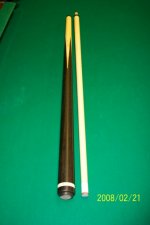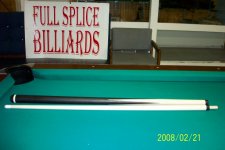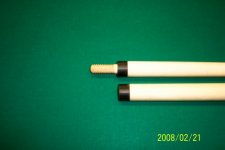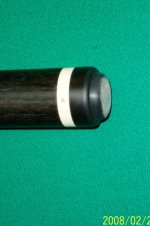Deano Cue Review by Craig at Full Splice Billiards
Well like I said in another thread I had a Deano Cue being sent to me for a cue review, and it arrived yesterday. First let me say that the over all look of the cue was pretty good. The construction was well engineered, obviously by someone who has the necessary skills to construct a quality cue.
The only initial construction issues that can be visually identified, is a lack of finishing touches that would include the cues finish and exterior finishing that are necessary before finish is applied. However, it is my understanding that these cues are prototypes and that future models will be completely finished to acceptable standards.
Cue Specifications:
1. Length - 58.5 inches
2. Weight - 19.2 oz
3. Wood Construction Butt - Ebony spliced into a maple forearm - Four
point Full Splice no veneers (House Cue Splice)
4. Shaft ? Maple Consonant / European Billiard Taper ( Diameter at the
tip 12.5mm - 2 inch from tip 13mm - 3.5 inch from tip 14mm - 8.5 inch
from tip 15mm - 12 inch from the tip 16.5mm - 24 inch from the tip
19.91mm - shaft collar 21.09 mm
5. Shaft Wood - The shaft wood on the cue I received for review is
certainly B-Grade. I would recommend that high quality shaft wood is
used for future models.
6. Joint - Wood Screw Standard Billiard cue. This joint is very very
strong, and stable. It has been a standard joint type used on and off
for at least 150 years. Currently this design is mainly used on
3-Cushion Billiards cues, but there is another gentleman currently
using this joint type in Missouri. It was also used for Pool cues by
Brunswick, Harvey Martin, and during the 1970's by Adam /
Helmstetter Cue Company.
7. Butt Cap / Joint material - Linen Phenolic Double Black.
After playing with this cue for approximately two hours I have made the following observations.
1. The cue has a very solid hit, although I am not comfortable with this cues
shaft taper which is too thick for me personally. I would recommend a
more standard shaft taper due to the fact that most players today and
most cues manufactured today use a shaft with a pro-taper or
something similar to one.
2. The cues weight is not equally distributed and due to this the cue
appears to be butt heavy, even without the addition of a weight bolt.
This could be corrected by incorporating the proper techniques to
balance the cue during construction.
3. While we all know that any cues hit is subjective to the person using
the cue, I liked this cues hit, and defection is kept to a minimum. This
is mainly due to the taper of the cues butt, and the shaft which are
straight tapered, along with the shaft diameter. By reducing the shaft
diameter, the over all deflection may increase.
4. Due to the design of this cue, which with its current taper is a
3-Cushion Billiards cue design you can certainly attain a great deal of
action on the cue ball with a good stroke.
To date I have had one of the better players that frequents my pool room tested this cue for around an hour. His assessment is basically the same as mine concerning playability of this cue in its current design.
Over all I liked the cue and I think the joint design and the hit it produces is very good. I also think that if Dean takes these cues into production that they will be well received if the minor adjustments to shaft taper, cue balance are corrected. In addition to the application of a good strong finish. I would currently recommend that these cues would be great for 3-Cushion Billiards as they are, with a weight reduction by coring or by using a different type of hardwood that is not as heavy in the cues butt. The reason for the weight reduction mainly concerns the fact that most 3-Cushion players prefer a cue that weights between 17 and 18.5oz.
This is my opinion, of Dean's cue; I have tried to be both fair and honest, I will post additional information when other players have had the time to test this cue.




Well like I said in another thread I had a Deano Cue being sent to me for a cue review, and it arrived yesterday. First let me say that the over all look of the cue was pretty good. The construction was well engineered, obviously by someone who has the necessary skills to construct a quality cue.
The only initial construction issues that can be visually identified, is a lack of finishing touches that would include the cues finish and exterior finishing that are necessary before finish is applied. However, it is my understanding that these cues are prototypes and that future models will be completely finished to acceptable standards.
Cue Specifications:
1. Length - 58.5 inches
2. Weight - 19.2 oz
3. Wood Construction Butt - Ebony spliced into a maple forearm - Four
point Full Splice no veneers (House Cue Splice)
4. Shaft ? Maple Consonant / European Billiard Taper ( Diameter at the
tip 12.5mm - 2 inch from tip 13mm - 3.5 inch from tip 14mm - 8.5 inch
from tip 15mm - 12 inch from the tip 16.5mm - 24 inch from the tip
19.91mm - shaft collar 21.09 mm
5. Shaft Wood - The shaft wood on the cue I received for review is
certainly B-Grade. I would recommend that high quality shaft wood is
used for future models.
6. Joint - Wood Screw Standard Billiard cue. This joint is very very
strong, and stable. It has been a standard joint type used on and off
for at least 150 years. Currently this design is mainly used on
3-Cushion Billiards cues, but there is another gentleman currently
using this joint type in Missouri. It was also used for Pool cues by
Brunswick, Harvey Martin, and during the 1970's by Adam /
Helmstetter Cue Company.
7. Butt Cap / Joint material - Linen Phenolic Double Black.
After playing with this cue for approximately two hours I have made the following observations.
1. The cue has a very solid hit, although I am not comfortable with this cues
shaft taper which is too thick for me personally. I would recommend a
more standard shaft taper due to the fact that most players today and
most cues manufactured today use a shaft with a pro-taper or
something similar to one.
2. The cues weight is not equally distributed and due to this the cue
appears to be butt heavy, even without the addition of a weight bolt.
This could be corrected by incorporating the proper techniques to
balance the cue during construction.
3. While we all know that any cues hit is subjective to the person using
the cue, I liked this cues hit, and defection is kept to a minimum. This
is mainly due to the taper of the cues butt, and the shaft which are
straight tapered, along with the shaft diameter. By reducing the shaft
diameter, the over all deflection may increase.
4. Due to the design of this cue, which with its current taper is a
3-Cushion Billiards cue design you can certainly attain a great deal of
action on the cue ball with a good stroke.
To date I have had one of the better players that frequents my pool room tested this cue for around an hour. His assessment is basically the same as mine concerning playability of this cue in its current design.
Over all I liked the cue and I think the joint design and the hit it produces is very good. I also think that if Dean takes these cues into production that they will be well received if the minor adjustments to shaft taper, cue balance are corrected. In addition to the application of a good strong finish. I would currently recommend that these cues would be great for 3-Cushion Billiards as they are, with a weight reduction by coring or by using a different type of hardwood that is not as heavy in the cues butt. The reason for the weight reduction mainly concerns the fact that most 3-Cushion players prefer a cue that weights between 17 and 18.5oz.
This is my opinion, of Dean's cue; I have tried to be both fair and honest, I will post additional information when other players have had the time to test this cue.




Last edited: